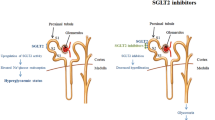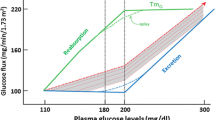Abstract
Treatment of type 2 diabetes mellitus (T2DM) continues to present challenges, with many patients failing to achieve glycemic targets. Despite the availability of many oral and injectable anti-diabetic agents, therapeutic efficacy is often offset by undesirable side effects such as hypoglycemia, weight gain and cardiovascular complications. Therefore, the search for new therapeutic agents with an improved benefit–risk profile continues. Recent research has focused on the kidney as a potential therapeutic target, especially because maximal renal glucose reabsorption is increased in T2DM. Under normal physiological conditions, nearly all filtered glucose is reabsorbed in the proximal tubule of the nephron via the sodium/glucose co-transporter 2 (SGLT2). SGLT2-inhibitors are a new class of oral anti-diabetes, which reduce hyperglycemia by increasing urinary glucose excretion independently of insulin secretion or action. Canagliflozin and dapagliflozin in US market, and ipragliflozin and luseogliflozin in Japan market are now available for glycemic control in type 2 diabetics. There are several phase III clinical ongoing trials involving this new class of medications. This review examines some of the key efficacy and safety data from clinical trials of the SGLT2 inhibitors approved, and their future perspectives in the treatment of T2DM.

Similar content being viewed by others
References
Asano, T., T. Ogihara, H. Katagiri, H. Sakoda, H. Ono, M. Fujishiro, M. Anai, H. Kurihara, and Y. Uchijima. 2004. Glucose transporter and Na+/glucose cotransporter as molecular targets of anti-diabetic drugs. Current Medicinal Chemistry 11: 2717–2724.
Bailey, C.J., J.L. Gross, A. Pieters, A. Bastien, and J.F. List. 2010. Effect of dapagliflozin in patients with type 2 diabetes who have inadequate glycemic control with metformin: A randomized, double-blind, placebo-controlled trial. Lancet 375: 2223–2233.
Black, C., P. Donnelly, L. Mcintyre, P.L. Royle, J.P. Shepherd, and S. Thomas. 2007. Meglitinide analogues for type 2 diabetes mellitus. The Cochrane Database of Systematic Reviews 2: CD4654.
Bode, B., K. Stenlöf, D. Sullivan, A. Fung, and K. Usiskin. 1995. Efficacy and safety of canagliflozin treatment in older subjects with type 2 diabetes mellitus: A randomized trial. Hospital Practice 41: 72–84.
Bolinder, J., O. Ljunggren, J. Kullberg, L. Johansson, J. Wildding, A.M. Langkilde, J. Sugg, and S. Parikh. 2012. Effects of dapagliflozin on body weight, total fat mass, and regional adipose tissue distribution in patients with type 2 diabetes mellitus with inadequate glycemic control on metformin. The Journal of Clinical Endoclinology & Metabolism 97: 1020–1031.
Burcelin, R., C. Knauf, and P.D. Cani. 2008. Pancreatic alphacell dysfunction in diabetes. Diabetes Metabolism 34: S49–S55.
Cersosimo, E., P. Garlick, and J. Ferretti. 1999. Insulin regulation of renal glucose metabolism in humans. American Journal of Physiology 276: E78–E84.
Chao, E.C., and R.R. Henry. 2010. SGLT2 inhibition: A novel strategy for diabetes treatment. Nature Reviews Drug Discovery 9: 551–559.
Copper, M.S., and P.M. Stewart. 2009. 11β-hydroxysteroid dehydrogenase type 1 and its role in the hypothalamus–pituitary–adrenal axis, metabolic syndrome, and inflammation. The Journal of Clinical Endocrinology and Metabolism 94: 4645–4654.
Croasdell, G. 2010. American Diabetes Association: 70th scientific sessions: Research on novel therapeutics: Part 1. The Investigational Dugs Journal 13: 595–597.
Diabetes Prevention Program Research Group. 2002. Reduction in the incidence of type 2 diabetes with lifestyle intervention or metformin. The New England Journal of Medicine 364: 393–403.
Drucker, D.J., and M.A. Nauck. 2006. The incretin system: Glucagon-like peptide-1 receptor agonists and dipeptidyl peptidase-4 inhibitors in type 2 diabetes. Lancet 368: 1696–1705.
Dudash Jr, J., X. Zhang, R.E. Zeck, S.G. Johnson, G.G. Cox, B.R. Conway, P.J. Rybczynski, and K.T. Demarest. 2004. Glycosylated dihydrochalcones as potent and selective sodium glucose co-transporters 2 (SGLT2) inhibitors. Bioorganic & Medicinal Chemistry Letters 14: 5121–5125.
Edgerton, D.S., K.M. Johnson, and A.D. Cherrington. 2009. Current strategies for the inhibition of hepatic glucose production in type 2 diabetes. Frontiers in Bioscience 14: 1169–1181.
Ehrenkranz, R.R.L., N.G. Lewis, C.R. Kahn, and J. Roth. 2005. Phlorizin: A review. Diabetes Metabolism Research Reviews 21: 31–38.
FDA. 2011. FDA briefing document. NDA 202293. Dapagliflozin tablets, 5 and 10 mg. Sponsor: Bristol-Myers Squibb. Advisory Committee Meeting.
Forst, T., R. Guthrie, R. Goldenberg, J. Yee, U. Vijapurkar, G. Meininger, and P. Stein. 2014. Efficacy and safety of canagliflozin over 52 weeks in patients with type 2 diabetes on background metformin and pioglitazone. Diabetes, Obesity & Metabolism 16: 467–477.
Fujimori, Y., K. Katsuno, I. Nakashima, Y. Ishikawa-Takemura, H. Fujikura, and M. Isaji. 2008. Remogliflozin etabonate, in a novel category of selective low-affinity/high-capacity sodium glucose cotransporter (SGLT2) inhibitors, exhibits antidiabetic efficacy in rodent models. The Journal of Pharmacology and Experimental Therapeutics 327: 268–276.
Grempler, R., L. Thomas, M. Eckhardt, F. Himmelsbach, A. Sauer, D.E. Sharp, R.A. Bakker, M. Mark, T. Klein, and P. Eickelmann. 2012. Empagliflozin, a novel selective sodium glucose cotransporter-2 (SGLT-2) inhibitor: Characterisation and comparison with other SGLT-2 inhibitors. Diabetes, Obesity & Metabolism 14: 83–90.
Gustavson, S.M., et al. 2004. Effects of hyperglycemia, glucagon, and epinephrine on renal glucose release in the conscious dog. Metabolism 53: 933–941.
Han, G.C., S.K. Ko, J.H. Sung, and S.H. Chung. 2007. Compound K enhances insulin secretion with beneficial metabolic effects in db/db mice. Journal of Agricultural and Food Chemistry 55: 10641–10648.
Han, S., D.L. Hagan, J.R. Taylor, L. Xin, W. Meng, S.A. Biller, J.R. Wetterau, W.N. Washburn, and J.M. Whaley. 2008. Dapagliflozin: A selective SGLT2 inhibitor, improves glucose homeostasis in normal and diabetic rats. Diabetes 57: 1723–1729.
Hediger, M.A., and D.B. Rhoads. 1994. Molecular physiology of sodium–glucose cotransporters. Physiological Reviews 74: 993–1026.
Hediger, M.A., M.J. Coady, T.S. Ikeda, and E.M. Wright. 1987. Expression cloning and cDNA sequencing of the Na(+)/glucose co-transporter. Nature 330: 379–381.
Hongu, M., N. Funami, Y. Takahashi, K. Saito, K. Arakawa, M. Matsumoto, H. Yamakita, and K. Tsujihara. 1998a. Na(+)–glucose cotransporter inhibitors as antidiabetic agents. III. Synthesis and pharmacological properties of 4′-dehydroxyphlorizin derivatives modified at the OH groups of the glucose moiety. Chemical & Pharmaceutical Bulletin (Tokyo) 46: 1545–1555.
Hongu, M., T. Tanaka, N. Funami, K. Saito, K. Arakawa, M. Matsumoto, and K. Tsujihara. 1998b. Na(+)–glucose cotransporter inhibitors as antidiabetic agents. II. Synthesis and structure-activity relationships of 4′-dehydroxyphlorizin derivatives. Chemical & Pharmaceutical Bulletin (Tokyo) 46: 22–33.
Hussey, E.K., R.L. Dobbins, R.R. Stoltz, N.L. Stockman, R.L. O’Connor-Semmes, A. Kapur, S.C. Murray, D. Layko, and D.J. Nunez. 2010. Multiple-dose pharmacokinetics and pharmacodynamics of sergliflozin etabonate, a novel inhibitor of glucose reabsorption, in healthy overweight and obese subjects: A randomized double-blind study. Journal of Clinical Pharmacology 50: 636–646.
Kahn, S.E., R.L. Hull, and K.M. Ulzschneider. 2006. Mechanisms linking obesity to insulin resistance and type 2 diabetes. Nature 444: 840–846.
Khan, S.E., S.M. Haffner, M.A. Heise, S.E. Kahn, S.M. Haffner, M.A. Heise, W.H. Herman, R.R. Holman, N.P. Jones, B.G. Kravitz, J.M. Lachin, M.C. O’Neill, B. Zinman, and G. Viberti. 2006. Glycemic durability of rosiglitazone, metformin, or glyburide monotherapy. The New England Journal of Medicine 355: 2427–2443.
Kim, S.J., H.Y. Quan, K.J. Kyong, D.Y. Kim, G.W. Kim, H.K. Jo, and S.H. Chung. 2014. Beneficial effect of betulinic acid on hyperglycemia via suppression of hepatic glucose production. Journal of Agricultural and Food Chemistry 62: 434–442.
Komoroski, B., N. Vachharajani, Y. Feng, L. Li, D. Kornhauser, and M. Pfister. 2009. Dapagliflozin: A novel, selective SGLT2 inhibitor, improved glycemic control over 2 weeks in patients with type 2 diabetes mellitus. Clinical Pharmacology and Therapeutics 85: 513–519.
Markham, A., and S. Elkinson. 2014. Luseogliflozin: First global approval. Drugs 74: 945–950.
Marsenic, O. 2009. Glucose control by the kidney: An emerging target in diabetes. American Journal of Kidney Disease 53: 875–883.
Matsuda, M., R.A. Defronzo, L. Glass, A. Consoil, M. Giordano, P. Bressler, and S. Delprato. 2002. Glucagon dose-response curve for hepatic glucose production and glucose disposal in type 2 diabetic patients and normal individuals. Metabolism 51: 1111–1119.
Merovci, A., C. Solis-Herrera, G. Daniele, R. Eldor, T.V. Fiorentino, D. Tripathy, J. Xiong, Z. Perez, L. Norton, M.A. Abdul-Ghani, and R.A. DeFronzo. 2014. Dapagliflozin improves muscle insulin sensitivity but enhances endogenous glucose production. The Journal of Clinical Investigation 124: 509–514.
Miao, Z., G. Nucci, N. Amin, R. Sharma, V. Mascitti, M. Tugnait, A.D. Vaz, E. Callegari, and A.S. Kalgutkar. 2013. Pharmacokinetics, metabolism, and excretion of the antidiabetic agent ertugliflozin (PF-04971729) in healthy male subjects. Drug Metabolism and Disposition 41: 445–456.
Mulder, H., C. Nagorny, V. Lyssenko, and L. Groop. 2009. Melatonin receptors in pancreatic islets: Good morning to a novel type 2 diabetes gene. Diabetologia 52: 1240–1249.
Nagata, T., M. Fukazawa, K. Honda, T. Yata, M. Kawai, M. Yamane, N. Murao, K. Yamaguchi, M. Kato, T. Mitsui, Y. Suzuki, S. Ikeda, and Y. Kawabe. 2012. Selective SGLT2 inhibition by tofogliflozin reduces renal glucose reabsorption under hyperglycemic but not under hypo- or euglycemic conditions in rats. AJP: Endocrinology and Metabolism 304: E414–E423.
Neumiller, J.J., J.R. White, and R.K. Campbell. 2010. Sodium-glucose co-transporter inhibitors: Progress and therapeutic potential in type 2 diabetes mellitus. Drugs 70: 377–385.
Ohtake, Y., T. Sato, T. Kobayashi, M. Nishimoto, N. Taka, K. Takano, K. Yamamoto, M. Ohmori, M. Yamaguchi, K. Takami, S.Y. Yeu, K.H. Ahn, H. Matsuoka, K. Morikawa, M. Suzuki, H. Hagita, K. Ozawa, K. Yamaguchi, K. Kato, and S. Ikeda. 2012. Discovery of tofogliflozin, a novel c-arylglucoside with ano-spiroketal ring system, as a highly selective sodium glucose cotransporter 2 (sglt2) inhibitor for the treatment of type 2 diabetes. Journal of Medicinal Chemistry 55: 7828–7840.
Poole, R.M., and R.T. Dungo. 2014. Ipragliflozin: First global approval. Drugs 74: 611–617.
Rahmoune, H., P.W. Thompson, J.M. Ward, C.D. Smith, G. Hong, and J. Brown. 2005. Glucose transporters in human renal proximal tubular cells isolated from the urine of patients with non-insulin-dependent diabetes. Diabetes 54: 3427–3434.
Reaven, G.M. 1988. Role of insulin resistance in human disease. Diabetes 37: 1595–1607.
Sha, S., D. Devineni, A. Ghosh, D. Polidori, S. Chien, D. Wexler, K. Shalayda, K. Demarest, and P. Rothenberg. 2011. Canagliflozin: A novel inhibitor of sodium glucose co-transporter 2, dose dependently reduces calculated renal threshold for glucose excretion and increases urinary glucose excretion in healthy subjects. Diabetes, Obesity & Metabolism 13: 669–672.
Stenlöf, K., W.T. Cefalu, K.A. Kim, M. Alba, K. Usiskin, C. Tong, W. Canovatchel, and G. Meininger. 2013. Efficacy and safety of canagliflozin monotherapy in subjects with type 2 diabetes mellitus inadequately controlled with diet and exercise. Diabetes, Obesity & Metabolism 15: 372–382.
Stumvoll, M., B.J. Goldstein, and T.W. van Haeften. 2005. Type 2 diabetes: Principles of pathogenesis and therapy. Lancet 365: 1333–1346.
Tsujihara, K., M. Hongu, K. Saito, M. Inamasu, K. Arakawa, A. Oku, and M. Matsumoto. 1996. Na(+)–glucose cotransporter inhibitors as antidiabetics. I. Synthesis and pharmacological properties of 4′-dehydroxyphlorizin derivatives based on a new concept. Chemical & Pharmaceutical Bulletin (Tokyo) 44: 1174–1180.
Uldry, M., and B. Thorens. 2004. The SLC2 family of facilitated hexose and polyol transporters. Pflügers Archiv 447: 480–489.
Wilding, J.P., P. Norwood, C. T’joen, A. Bastien, J.F. List, and F.T. Fiedorek. 2009. A study of dapagliflozin in patients with type 2 diabetes receiving high doses of insulin plus insulin sensitizers: Applicability of a novel insulin-independent treatment. Diabetes Care 32: 1656–1662.
Wright, E.M. 2001. Renal Na(+)–glucose cotransporters. American Journal of Physiology: Renal Physiology 280: F10–F18.
Wright, E.M., D.D. Loo, and B.A. Hirayama. 2011. Biology of human sodium glucose transporters. Physiological Reviews 91: 733–794.
Yuan, H.D., and S.H. Chung. 2010. Protective effects of fermented ginseng on streptozotocin-induced pancreatic β-cell damage through inhibition of NF-κB. International Journal of Molecular Medicine 25: 53–58.
Zambrowicz, B., J. Freiman, P.M. Brown, K.S. Frazier, A. Turnage, J. Bronner, D. Ruff, M. Shadoan, P. Banks, F. Mseeh, D.B. Rawlins, N.C. Goodwin, R. Mabon, B.A. Harrison, A. Wilson, A. Sands, and D.R. Powell. 2012. LX4211, a dual SGLT1/SGLT2 inhibitor, improved glycemic control in patients with type 2 diabetes in a randomized, placebo-controlled trial. Clinical Pharmacology and Therapeutics 92: 158–169.
Author information
Authors and Affiliations
Corresponding author
Rights and permissions
About this article
Cite this article
Kim, G.W., Chung, S.H. Clinical implication of SGLT2 inhibitors in type 2 diabetes. Arch. Pharm. Res. 37, 957–966 (2014). https://doi.org/10.1007/s12272-014-0419-0
Received:
Accepted:
Published:
Issue Date:
DOI: https://doi.org/10.1007/s12272-014-0419-0




